Financial Stability Review – April 2018 Box B: Recent Trends in Personal Credit
Personal credit accounts for a small share of household credit and a very small share of banks' total domestic lending. Nonetheless, banks' non-performing ratio on personal credit has been drifting upwards over recent years. This box examines the factors behind this trend. Overall, the recent rise in the ratio of non-performing personal loans does not appear to be indicative of a broader deterioration in household finances. Instead, the rise seems to mostly reflect cyclical effects of economic conditions in mining-exposed states, as well as structural changes in lending markets that resulted in a change in the composition of personal credit towards borrowers who have lower creditworthiness, on average. This is because mortgagors, who typically display greater creditworthiness, have been able to increasingly use housing-secured financing to fund consumer spending. The changes in the use of personal credit and in borrower type confound the usefulness of personal credit indicators as measures of overall household financial health.
Components of Personal Credit and Recent Trends in Non-performing Loans
Personal credit is borrowing by households that is not related to residential housing or for the purpose of funding unincorporated businesses. It can be divided into two broad categories: fixed-term loans and revolving credit facilities (Graph B1). Fixed-term loans are typically for an agreed loan size that is fully drawn down and must be paid back within a pre-determined period. They are typically undertaken for the purchase of large consumer items such as cars and holidays. Revolving credit facilities usually have a credit limit that can be used when required with no fixed repayment schedule. This lending is split into credit card debt and other revolving credit.
After rising strongly in the years prior to the global financial crisis, personal credit balances from Australian banks have remained fairly stable for the past decade, at around $110 billion (Graph B1).[1] This contrasts with the growth in mortgage lending, which has more than doubled during that period, so that the share of personal credit in Australian banks' lending to the household sector has fallen, from 12 per cent in 2009 to just 6 per cent of late. Over two-fifths of this debt represents fixed-term loans, two-fifths credit card debt and the remainder other revolving credit. Other revolving credit, which largely represents margin lending to purchase equities or other financial assets, has been declining gradually over time due to reduced risk appetite post the financial crisis and new responsible lending obligations in regard to margin lending that were introduced in 2010.[2]
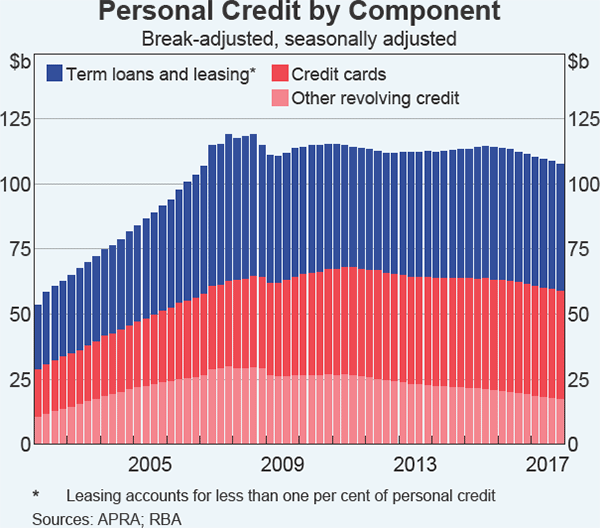
While the level of personal credit has been flat in nominal terms for a decade, the share of non-performing loans within that aggregate has been drifting higher for over a decade (Graph B2).[3] This trend is evident in data for both credit card debt and other personal debt. Moreover, while loan performance for housing credit improved for a few years shortly after the global financial crisis, the non-performing ratio for personal lending did not decline at this time.
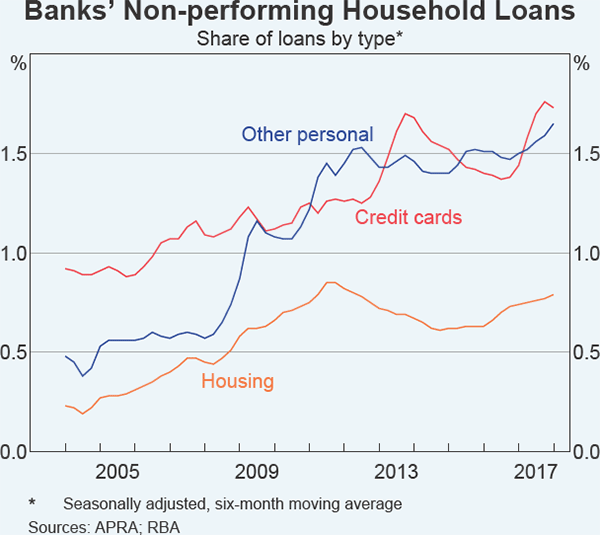
Factors Affecting Non-performing Personal Credit
There are a range of structural, cyclical, and reporting factors that appear to have contributed to the upwards drift in banks' non-performing personal credit. Several structural changes in the lending market have likely led to a change in the composition of personal credit towards borrowers who have lower creditworthiness, on average. The availability and use of redraw facilities and offset accounts linked to residential mortgage loans has increased over time and the vast majority of mortgages have either redraw facilities attached to them, offset accounts or both.[4] Indeed, balances in these accounts are now well over double the total stock of personal credit (Graph B3). Drawing down on offset and redraw accounts enables borrowers to fund large expenditures such as home renovations, car purchases, or even pay off credit card balances, without having to take out a personal loan. Banks have contributed to this switch in borrowing behaviour by widening the interest rate differential between (secured) mortgages and (generally unsecured) personal credit, with a notable repricing in 2008 that reflected a reassessment of risk at the time of the global financial crisis (Graph B4). As a consequence, liaison with banks suggests that borrowers who seek fixed-term personal loans are increasingly a pool of renters, younger and/or lower-income borrowers, all of whom typically have a higher level of non-performing loans than homeowners.
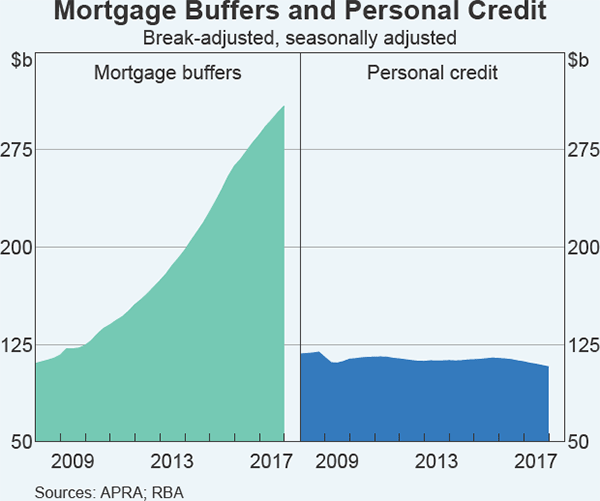
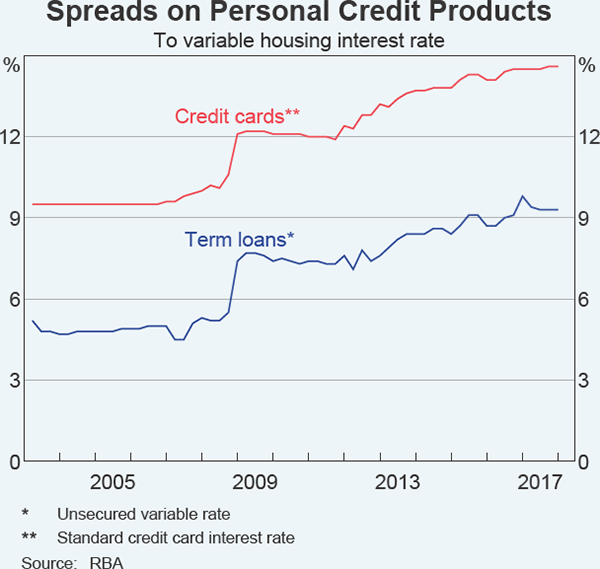
Data from the Survey of Income and Housing indicate that the share of credit card and motor vehicle debt that is held by the lowest income quintile increased from 5 per cent in the 2003/04 survey to just under 10 per cent in 2015/16 and that the share held by renters increased from about one-quarter to around one-third. Over the same period, the share of the total number of loans held by renters as well as by lower-income households also increased. The structural change introduced into mortgage lending products can help explain both the lack of growth of personal credit over the past decade as well as the rising share of non-performing loans within that aggregate.
The same structural change might account for the gradual rise in non-performing loans for credit card debt. Most cardholders are increasingly using credit cards for transactional purposes rather than for borrowing. The share of cardholders who always pay off their credit card balances in full each month has increased over the past decade (Graph B5). In line with this, the share of credit card debt accruing interest has declined from 72 per cent in 2007 to about 62 per cent currently. The growing habit of repaying it in full each month accounts for the stable stock of credit card debt, despite their increased use as a means of payment. Given mortgagors have the ability to use offset and redraw facilities to finance large consumer purchases, it is likely they account for much of the decrease in the use of credit cards as a means of financing purchases that are paid off over time. This suggests that it is younger and lower-income borrowers (who typically rent) who constitute a larger share of those using credit cards to fund purchases that are paid off gradually over time. Data from HILDA also suggest renters are more likely to pay interest on credit cards than owner-occupiers, consistent with owner-occupiers having access to other sources of debt, and tending to be older and having higher income.
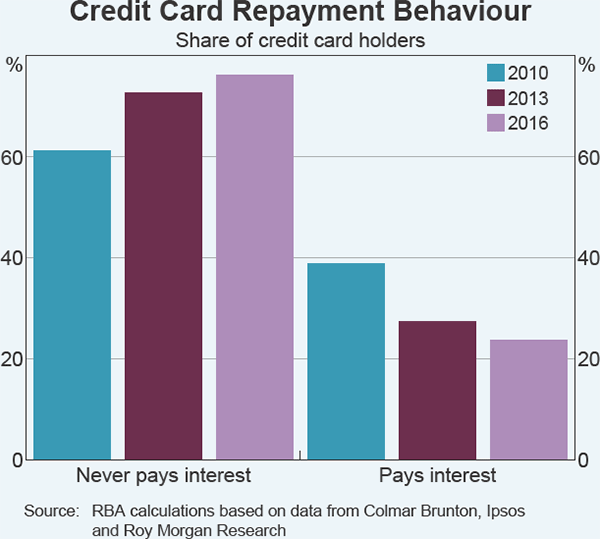
Nonetheless, there is some evidence that the rise in non-performing personal loans reflects a cyclical increase in financial stress of households in some parts of the country. In liaison with the RBA, banks have stated that the challenging economic conditions in Western Australia and parts of Queensland following the unwinding of the mining investment boom are contributing to the rise in non-performing personal loans. Households in these areas have experienced falls in income and property prices, as well as rising unemployment, thus making it harder for them to repay both their housing and personal loans. Accordingly, these areas have also seen a rise in personal administrations.[5] The share of personal administrations in mining-exposed states relative to the total rose from around 30 per cent in 2009 to 40 per cent in 2017. Banks also report that there has been little change in non-performing ratios outside of these mining-related areas.
Lastly, part of the increase in banks' non-performing loans reflects reporting changes, in particular related to the reporting of hardship accounts. Under consumer credit laws, banks (and other lenders) are obliged to consider variations in the credit contracts of borrowers who are experiencing temporary financial hardship. In 2012, APRA clarified how loans in hardship should be reported in order to improve consistency across lending institutions. This change has increased the reported level of non-performing loans, although the consequent increase was relatively small in aggregate and has been spread over several years as banks introduced the new reporting standard at different times.
Footnotes
Around 75 per cent of total personal credit is provided by banks. [1]
Margin loans enable households to have a leveraged exposure to equity markets. For details see Wong A (2009), ‘Recent Developments in Margin Lending in Australia’, RBA Bulletin, December. [2]
Non-performing loans comprise well-secured loans that are at least 90 days in arrears, as well as impaired loans, where the full repayment of interest and principal is doubtful and the loan is not well secured. [3]
Redraw facilities give the borrower the option of withdrawing accumulated mortgage prepayments and offset accounts act as an at-call deposit account, with funds in the account netted against the borrower's outstanding mortgage balance for the purposes of calculating interest on the loan. [4]
Personal administrations include bankruptcy, debt agreements and personal insolvency agreements. [5]